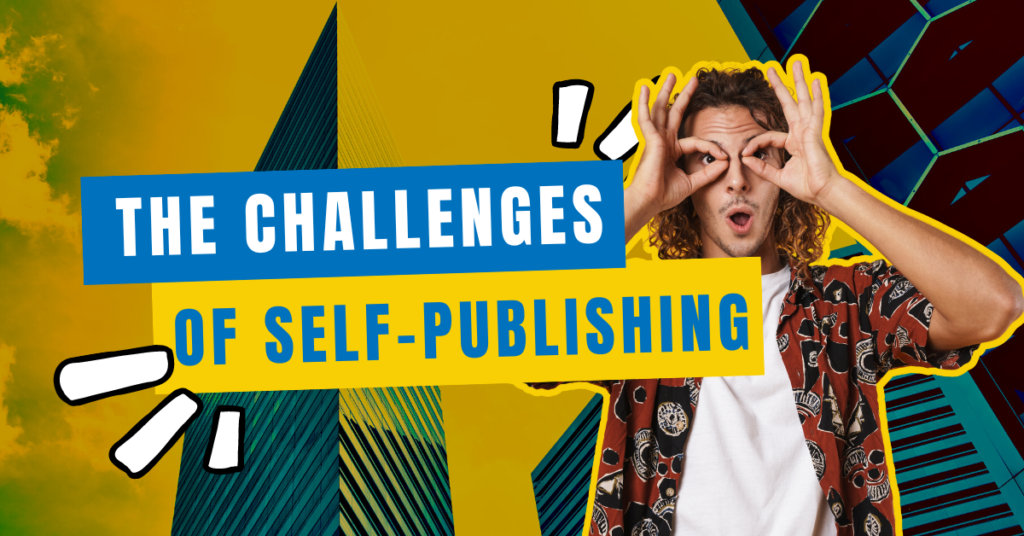I. Introduction
Self-publishing is an increasingly popular option for authors looking to get their work into the world. It’s a way for writers to maintain control over their work, save on production costs, and have more creative freedom in design, marketing, and distribution. But first, address the challenges of self-publishing before your book can reach its full potential.
In simplest terms, self-publishing is the process by which an author produces and distributes their books without relying on a traditional publishing house. This means no editor providing feedback or marketing team promoting the book; instead, authors are tasked with formatting, designing cover art, setting prices, and getting books into readers’ hands all on their own.
Overview of the self-publishing landscape
Self-publishing has become an increasingly popular way for authors to get their work into the world. However, self-publishing can entail several challenges for authors who must familiarize themselves with the process. In addition, many aspiring authors may be overwhelmed by the different paths and options to successfully self-publish their work.
Plenty goes into self-publishing, from choosing a platform, setting up an account, formatting a manuscript, and more. One of the essential aspects is understanding how each platform works and what services they offer that might benefit your publishing project.
II. The challenge of producing a high-quality product
Editing and proofreading
Editing and proofreading are two integral parts of the self-publishing process. It is crucial to ensure that your work is polished, professional, and error-free before you hit publish. Unfortunately, authors often need to pay more attention to the importance of editing and proofreading their work, leading to mistakes that can leave a lasting negative impression on readers.
Sound editing and proofreading require a great deal of time, patience, and attention to detail. Please read through your work several times to identify any typos or spelling mistakes and any inconsistencies in tone or structure. It’s also worth having someone else look over your work for a fresh perspective – ideally, another author who can offer constructive feedback on how you might improve your writing.
Cover design and layout
Self-publishing has become a popular way for authors to get their work into the world. But that doesn’t mean it’s easy. For example, one of the most difficult challenges self-publishers face is designing and laying the cover. To create an eye-catching and professional-looking cover that will draw readers in, you need skill, creativity, and knowledge of design principles.
Creating a beautiful book cover is one of the most important aspects of self-publishing. It sets your book apart from others in the market, grabs attention, and gives potential buyers an idea of what type of story they can expect upon reading it. The design should be simple yet professional, with enough detail to stand out among other books while being aesthetically pleasing.
Formatting for print and digital platforms
In the modern era of self-publishing, authors face several challenges. One of these is formatting for both print and digital platforms. Not understanding how to format for each medium can lead to headaches down the line as authors attempt to make their books available in multiple formats.
Print formats require a different layout from digital versions, which can be tricky if an author needs to become more familiar with the process. For optimal results, it’s important to consider page size and margins when creating a print edition of your book. Additionally, ensuring that images are high resolution and text is legible will help make an aesthetically pleasing read.
Digital formatting is likewise complex; ebook readers have different requirements than web browsers or mobile devices—so it’s essential to understand which file works best on each platform.
III. Marketing and promoting your book
Building an author platform
Building an author platform is essential for any self-published author. It can be not easy, but it’s the key to getting your book noticed and selling copies. It would be best to take several crucial steps to build a compelling author platform from scratch. Firstly, you’ll need to decide which social media platforms you wish to use to market yourself and your book. You could opt for Twitter, Facebook, or even Instagram; each has its pros and cons depending on the type of content you want to share. Secondly, connect with other industry authors so they can help promote your work when it launches. Utilizing influencers in this way will help spread the word about your book and get it out into the public discourse.
Reaching out to potential readers.
Reaching out to potential readers can be one of the most significant challenges facing self-published authors. Unfortunately, it is difficult to gain public attention and break through the noise of other published works. Also, many traditional publishing houses would instead invest in unknown talent, leaving independent authors to need more visibility.
Self-promotion is essential for any author looking to launch a book, whether through creating an online presence or attending book fairs and readings. Developing relationships with bookstores, giving interviews and reviews on radio shows and podcasts, or even running promotions on social media platforms can all be helpful ways to reach readers. A great way to start building your audience is by connecting with literary blogs, magazines, and reviewers – anyone interested in featuring you or talking about your work.
The role of social media and online marketing
The world of self-publishing is dynamic, with authors facing challenges such as marketing, distribution, and building an audience. As the industry has evolved, so have the strategies for reaching readers. No longer are traditional methods alone enough; social media and online marketing can be essential components of an author’s success.
Social media sites provide a cost-effective way to reach a broad audience quickly and repeatedly. Authors can build relationships with their readers through engaging content and conversations in real-time. Through targeted campaigns, authors can develop their loyal fan base by connecting directly with them on platforms like Twitter or Instagram, allowing authors to build personal connections that could lead to sales and other growth opportunities. Additionally, online forums like Reddit create powerful word-of-mouth publicity for new books or releases that an author may need to be able to achieve through traditional means.
IV. Financial considerations
The cost of self-publishing
Self-publishing is no longer a distant dream but a reality. Over the past few years, self-publishing has become increasingly popular among authors, giving them more control and freedom to create their books. However, despite its advantages, it also comes with high costs that potential authors should consider before leaping.
The cost of self-publishing depends mainly on how much effort and money you’re willing to put in. It can range anywhere from a couple of hundred dollars for essential services such as editing and cover design to thousands of dollars for advertising and marketing campaigns. Moreover, you will also have to pay publishing fees like ISBN registration fees or other administrative costs associated with getting your book out there.
Pricing your book
Self-publishing can be a great way to publish your book without the need for traditional publishing routes. However, it presents its unique challenges, one of which is pricing your book. To effectively sell your book, you must consider several factors when setting the price.
Before deciding on a price point for your book, it’s essential to consider the current market value and what other authors charge. You could also research different distributors and how they collect royalties based on your chosen list price. It’s always best to avoid caution when selecting a selling price for your book – if it’s too high, readers will be less likely to purchase; if it’s too low, you won’t reap as many financial rewards from sales.
Generating income from sales
Generating income from sales can be a formidable task for those aspiring to become successful self-publishers. Without the marketing resources and support traditional publishers provide, it is up to the self-publisher to create a product that meets their expectations and resonates with their target audience. With careful planning and precise execution, authors have been able to maximize profits through thoughtful pricing models and effective promotional campaigns.
Self-publishing presents numerous obstacles that require strategic problem-solving to succeed.
For example, authors must determine appropriate pricing strategies for physical and digital products, identify potential customers, research print-on-demand services or distribution channels, and build relationships with influencers and other industry professionals to promote their work.
Also, create effective marketing plans utilizing social media platforms such as Facebook Ads or Twitter Ads and so much more!
V. Balancing self-publishing with other commitments
Time management and organization
As self-publishing continues to grow in popularity, authors need to be aware of the different challenges that come with the process. Time management and organization can be two of the most challenging aspects. It takes a great deal of discipline and focuses on staying ahead of deadlines and ensuring that details don’t slip through the cracks. This is especially true if you’re juggling multiple projects at once or trying to balance self-publishing with other writing tasks.
For successful writers, creating effective systems for managing their time is essential. To address the challenges of self-publishing, break down tasks into manageable chunks and must schedule each completed job. Setting aside dedicated periods for editing, research, and drafting is also a critical component of staying organized during self-publishing projects.
Dealing with the stress of self-publishing
Self-publishing is becoming increasingly popular as an avenue for authors to get their books out into the world. However, it can also be a daunting process that can be laden with stress. This article will discuss the challenges of self-publishing and how to deal with them to make the experience more manageable.
Self-publishing comes with its own set of unique issues that authors must tackle to ensure success. These include formatting issues, getting your book noticed by readers, marketing and promotion, dealing with feedback from reviewers, tracking sales numbers, and figuring out payment processing options. With so much responsibility on the author’s shoulders, it’s no wonder self-publishing can sometimes be stressful.
Fortunately, there are actionable processes you can take to reduce this stress level when tackling the challenges of self-publishing.
Maintaining a healthy work-life balance
Maintaining a healthy work-life balance is essential to one’s overall health and well-being. Self-publishing can be a great way to get your work out there, but it can also come with unique challenges. Knowing how to manage your time between work and life commitments properly is essential for success in self-publishing or any other career endeavor.
Finding the time to write and market your material while maintaining a healthy work-life balance is one of the biggest challenges of self-publishing. It’s easy to become overwhelmed and stressed by the demands of writing, marketing, social media management, editing, and other tasks associated with self-publishing. To help achieve balance, try setting reasonable weekly goals you know you can accomplish without overworking yourself.
VI. Conclusion
Self-publishing is becoming an increasingly attractive option for authors who want to make their work available to the public. However, while self-publishing can give writers more control over the creative process and reap a more significant share of profits, it comes with its unique challenges.
One significant benefit of self-publishing is that authors have complete control over their work. Writers can determine which genres they want to focus on, design how books are formatted and decide when they should be released. As a result, self-published authors can earn a higher royalty than those who go through traditional publishing houses; however, they must overcome many obstacles to succeed.
In conclusion, self-publishing is a complex yet rewarding endeavor. It can be a great way to realize the dream of becoming an author, but it also has its challenges. However, anyone can make their dream come true by understanding the benefits and drawbacks of self-publishing and some tips for overcoming these challenges. In addition, investing in professional services for editing, cover design, and marketing will help ensure your book reaches its intended audience.





